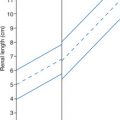Chapter 7. Abdomen and Retroperitoneum
Patient Preparation
• Fasting for 6 to 8 hours before the scan is preferable, but it may be done without preparation.
Equipment and Technical Factors
• A curved linear is the most common transducer used; a sector/vector transducer improves access through small acoustic windows.
Imaging Protocol
Minimum documentation images for the area of interest
• Longitudinal and transverse axes images should be obtained of the area of interest.
• The abdominal aorta and IVC proximal, mid, and distal portions should be documented in longitudinal and transverse images; vessel branches and tributaries should be included at the documentation levels.
• Measurements are performed as required by protocol or presence of pathology.
• Measurements must be performed according to the plane (perpendicular to the longitudinal axis) of the vessel because of angulation or tortuosity that occurs with enlargement or aging.
• To avoid confusion from the variety transducer placements that may be used to obtain diagnostic images of the area of interest, each image must be labeled accurately for scan plane and anatomy demonstrated.
• Images of healthy adrenal glands in the adult may be difficult to obtain.
Sonographic Measurements
There are no specific measurements for peritoneal and retroperitoneal cavities with or without the presence of disease.
Aorta
Outer to outer diameter; upper limits of normal
• 2.5−3.0 cm at the diaphragm
• 2.0 cm at midabdomen
• Ectasia: abdominal aortic enlargement <3.0 cm
• Aneurysm: focal dilatation of abdominal aorta >3.0 cm
IVC
• Less than 2.5 cm to a maximum of 4.0 cm; varies with respiration
Adult adrenal gland
• 3.0−5.0 cm length
• 2.0−3.0 cm width
• 3.0−6.0 mm depth (thickness)
| Abdomen and Retroperitoneum | |||
|---|---|---|---|
| Sonographic Finding(s) | Clinical Presentation | Differential Diagnosis | Next Step |
Aorta is enlarged but is <3.0 cm in diameter (perpendicular to longitudinal axis of vessel, outer to outer wall) Aorta may demonstrate angulation or tortuosity | Asymptomatic Elderly patient | Ectasia of the aorta | Ensure accurate measurement technique for follow-up studies May slowly progress to AAA |
Aorta is enlarged, >3.0 cm in diameter (perpendicular to longitudinal axis of vessel, outer to outer wall) | Asymptomatic Pulsatile abdominal mass Abdominal bruit | AAA (fusiform) | 5.0–6.0 cm diameter: likely surgical intervention ≥7.0 cm: high risk of rupture and surgical intervention |
Aorta is dilated circumferentially but may bulge somewhat toward patient’s left Homogenous clot may be noted along anterior/anterolateral wall Aorta may demonstrate angulation or tortuosity Color Doppler demonstrates turbulent, swirling flow | Demonstrate relationship of AAA to renal arteries or extension into common iliac arteries Lumen may be measured | ||
Pulsating or moving “flap” within aorta or aneurysm Color Doppler imaging demonstrates blood flow on both sides of the “flap” | History of AAA Severe chest and back pain
Stay updated, free articles. Join our Telegram channel
Full access? Get Clinical Tree


| ||

